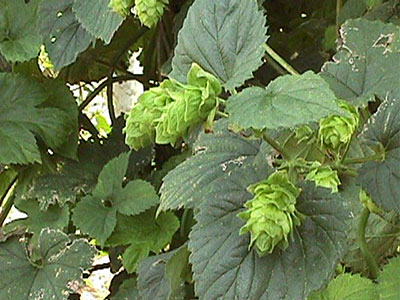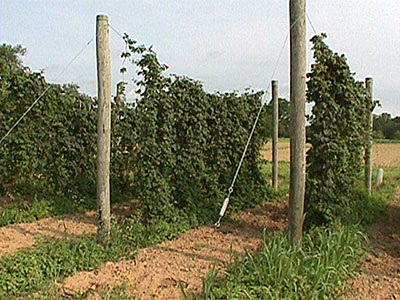Fact Sheet FS992
Introduction
If you are a homebrewer and enjoy gardening, you are a candidate for growing your own hops. The hop plant (Humulus lupulus) is a hardy perennial that produces annual vines from overwintering rootstock. The primary use of hops is in the manufacture of beer. The hop plant is dioecious, that is it has separate male and female plants. Only the female plant produces the cones used in brewing. The male plant is not necessary for the female plant to produce lupulin. Lupulin contains the oils and resins that give hops their aroma.

Female Hop Cones.
Growing hops in the northeast dates back to the colonial era. Hops were first introduced into Massachusetts from Europe in 1629. Commercial hop yards in the United States were reported to have been established in New York in the early 1800s. Commercial hops production was pushed westward during the 1920s by plant diseases encountered in the east, primarily downy mildew. Modern hops production is currently in the western United States in Oregon, Washington, and Idaho—areas less conducive to plant diseases of the humid east. Though commercial hops production no longer occurs in the east it is still possible to produce hops on a small scale in your backyard. In fact, Rutgers has successfully produced hops in research trials in central New Jersey.
Planting
Before planting hops you will need to spend some time planning the layout of your hop yard. Keep in mind that hop plants will grow 15 to 20 feet high. Make sure you choose an area with sufficient vertical space. Hops grown commercially in the Pacific Northwest are produced on a 15-foot high trellis system. The study at Rutgers used a 10-foot trellis to facilitate hand harvesting. For backyard production it is possible to string plants from a balcony, eves, along a fence or to erect poles with overhead wires like commercial growers. For backyard production the exact height is not as important as having room for the plant to stretch out. The hop yard should be located in an area that receives full sunlight and offers some protection from wind. Strong winds can damage or break the plants. Also choose a location that has well drained soil.

Hop Trellis System.
Hop Trellis System
Hops can be planted in the spring as early as the ground can be worked and the danger of frost has passed. Hops are propagated from rhizomes that are generally available from March to May. Rhizomes can be obtained through mail order or local home brewer supply shops. Rhizomes should be kept cool and moist until ready to plant. It is important to space the plantings to allow for sufficient room to grow. Rows should be spaced about 8 feet apart. Within each row plants are planted in hills spaced 2 to 3 feet apart. When establishing plants, rhizomes should be planted two in a hill. The first season's growth will not yield many cones. This time is spent on establishing the crown and root system of the plant.
Training the Plants
In the spring and early summer the hop vines grow rapidly. The shoots or vines can reach lengths in excess of 15 feet. During mid May when the young vines are approximately one to two feet the vines are trained. The main concern is to support the vines and prevent the side branches from tangling. This is done by selecting three to four vigorous vines for training. The remaining vines are pruned. Two lengths of baling twine or similar cord is stretched from the overhead trellis wires to the ground for each plant. The twine is anchored to a small stake at ground level. The baling twine provides support for the growing plant. The three to four vines are trained clockwise around the twine. Baling twine is used because it can support the weight of the plant and the coarse hairs of the hop bines can grip it. The hop vines are trained until the vines reach the top of the trellis. Once the vines reach the top of the trellis the vines will produce side branches where cones will be produced. At several points during the growing season the plants must be pruned, as the rhizome will continue to produce vines. Once the vines reach the top of the trellis and begin producing side branches the lower 2 to 3 feet of foliage can be stripped. Removal of the lower foliage aids in air circulation and reduces the possibility of disease. Removal of the lower leaves must be done carefully to avoid breaking or damaging the main stem.
Watering
Hops have a large leaf area and a significant water requirement. The roots of the plant will not tolerate standing water. This is why a well-drained soil is important. During initial establishment, frequent light waterings are sufficient. Once the plants are established hops will require approximately 1.5" of water equivalent per week. A drip irrigation system or soaker hose is preferred to a sprinkler system. This is because wet foliage can encourage disease formation.
Fertilizer
Hops produce best on deep, well-drained soils. Soils with a pH of 6.0 to 7.0 are best for hop production. Nitrogen is required at a rate of approximately 150 lbs. per acre (3-lbs/1000 sq. ft.). Studies in commercial hop production areas have shown that the hop plant phosphorus requirement is small. Hops produced in commercial yards typically remove 20 to 30 lbs. phosphorus per acre (0.5 lbs/1000 sq.ft). Potassium is required at a rate of approximately 150 lbs. per acre (3 lbs/1000 sq. ft.).
Insects/Diseases
Spider mites, leaf hoppers, aphids, Japanese beetles, European corn borer, and hop merchant are pests that have been encountered in New Jersey. Diseases to which hops are susceptible, include: downy mildew, powdery mildew, and verticillium wilt. Selection of a disease resistant variety is the first defense against disease. Check the catalog from the hops nursery to determine varietal resistance.
Harvest
Harvesting your hops will not have the benefit of the mechanized equipment used in commercial hops production. Your hops harvest will be done by hand. Two methods you can follow to harvest your hops are: to cut the vines from their trellis when the majority of the cones are mature. When cutting vines to pick first cut the lower end of the vine three feet from the ground. This will help prevent injury to the roots and crown. The second method is to pick the cones from the vine as they reach maturity. Because cones mature at different rates you can expect several harvests. No matter which method you use the hops should be pruned back at the end of the season. If you leave two or three feet of vine they can be buried for propagating new plants the following spring.
How do you know when your hops are ready to be picked? Both feel and smell are involved. If the hop cone is not ripe it will feel soft, slightly damp to the touch, and remain compressed when squeezed. Ripe hop cones will feel light and dry, and spring back when squeezed. When ripe the lupulin glands at the base of the cone petals will have a golden yellow color and a sticky residue that is fragrant when squeezed. Proper drying and storage is also essential for a successful hop harvest.
Drying
Once your hops are picked it is important to dry them to prevent mold or mildew from spoiling them. If you choose, dry your hops with a food dehydrator or oven. If you choose to use heat for drying your hops do not let the temperature exceed 140 degrees F. Another method of drying is to let them air dry. Spreading them evenly across a window screen can easily do this. The window screen should be placed off the ground in an area free from wind, bugs and bright light. The cones should be turned once a day. Using this method the hop cones should be dry in a few days. How will you know when your hop cones are ready for storage? The cones will be springy when touched and the yellow lupulin will easily fall from the cones. Also, the hop cone's inner stem will be brittle and snap when the cone is dry.
Storage
Once your hop cones are dry they need to be stored properly. Moisture, air, and heat will reduce the quality and freshness of your hops. Hops should be stored in a cool, dry, and dark place such as a freezer or refrigerator. Place hop cones in a sealable plastic bag with air squeezed out. Label and date your stored hops.
Sources of Hop Rhizomes
Freshops
36180 Kings Valley Highway
Philomath, OR 97370
Singing Tree Farm
1229 Snohomish, WA 98290
May Nursery Co.
212 North 3rd Ave
Yakima, WA 98901
Bluebird Nursery, Inc.
PO Box 460
Clarkson, NE 68629
Capitol Hop Farms, Inc.
9015 Windsor Island Rd. N.
Salem, OR 97330
Anderson's Nursery
Rt.1, Box 330, Arboretum Rd.
Corvallis, OR 97330
Nichol's Garden Nursery, Inc.
1190 Old Salem Rd. NE
Albany, OR 97321
Reference
- U.S.A. Hops Resource Guide, Hop Growers of America Hops Fertilizer Guide (FG 79) Oregon State Univ. Ext.
Mention or display of a trademark, proprietary product, or firm in text or figures does not constitute an endorsement by Rutgers Cooperative Extension and does not imply approval to the exclusion of other suitable products or firms.
January 2002
Copyright © 2024 Rutgers, The State University of New Jersey. All rights reserved.
For more information: njaes.rutgers.edu.
Cooperating Agencies: Rutgers, The State University of New Jersey, U.S. Department of Agriculture, and Boards of County Commissioners. Rutgers Cooperative Extension, a unit of the Rutgers New Jersey Agricultural Experiment Station, is an equal opportunity program provider and employer.

